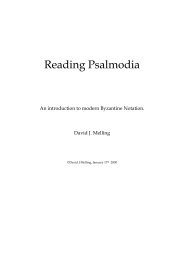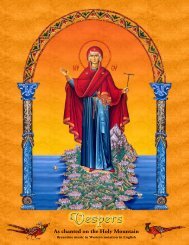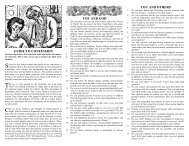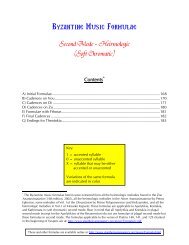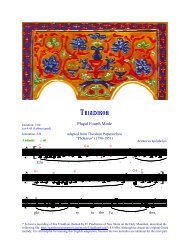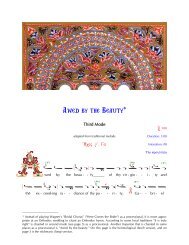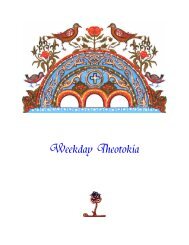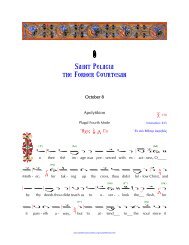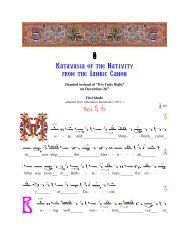Byzantine versus Western Notation - St. Anthony's Monastery
Byzantine versus Western Notation - St. Anthony's Monastery
Byzantine versus Western Notation - St. Anthony's Monastery
Create successful ePaper yourself
Turn your PDF publications into a flip-book with our unique Google optimized e-Paper software.
iv<strong>Byzantine</strong> vs. <strong>Western</strong> <strong>Notation</strong>5) <strong>St</strong>andard <strong>Western</strong> notation is incapable of accurately expressing the proper intervals of<strong>Byzantine</strong> music. Although it can approximate most <strong>Byzantine</strong> scales such that the error isnever greater than 2 μόρια (33 cents), it cannot approximate the scale of the soft chromatic modalgenre without producing an error of less than 4 μόρια (67 cents). This large error considerablyalters the ὕφος (the “hue”) of troparia in this modal genre. (This problem is discussed atgreater length online at: http://www.stanthonysmonastery.org/music/Chromatic.htm)6) Many people familiar with <strong>Western</strong> music have learned to associate music written in<strong>Western</strong> notation with a certain style of singing that is foreign to the traditional style of <strong>Byzantine</strong>chant. For example, some of them might tend to sing music in <strong>Western</strong> notation with excessivevibrato, with a subtle crescendo on every note, or in a disjunctive manner (i.e., by silencingtheir voice for a fraction of a second before beginning the next note). Although <strong>Byzantine</strong>notation in and of itself will not hinder such people from applying this same <strong>Western</strong> styleof singing to it, it will nevertheless serve as a visual reminder that <strong>Byzantine</strong> chant is quite differentfrom <strong>Western</strong> singing.Although the words “sing” and “chant” in English can both be used in reference to executingliturgical music, we prefer to use the word “chant” instead of “sing” in order to preserve thesame distinction that exists between the corresponding words in Greek. Photios Kontoglou ofblessed memory (1895-1965) explained that the distinction between these two terms in Greeklies in the spiritual differences between secular and ecclesiastical music. In particular, he wrote:“Spiritual feelings are expressed only by ecclesiastical music. Only ecclesiastical music canexpress the secret movements of the heart, which are completely different than what worldlymusic expresses. For this reason, the two kinds of music [European and <strong>Byzantine</strong>] are totallydifferent, just as shown by the words ‘sing’ (τραγουδῶ) and ‘chant’ (ψάλλω).” 47) The rules of standard <strong>Western</strong> notation dictate that a new time signature be insertedwithin a melody every time the rhythm changes. But since <strong>Byzantine</strong> melodies are characterizedby syllabic rhythm (i.e., the rhythm is derived from the pattern of accentuated syllables),such melodies transcribed into <strong>Western</strong> notation would be burdened by dozens of time signatures,thus rendering the score awkward. Moreover, melodies written in <strong>Byzantine</strong> notation caneasily be annotated with “abridged rhythm” (συνεπτυγμένος ρυθμός), which, in the words ofDemetrios Sourlantzis, lends the melodies “grandeur, solemnity, modesty, sacredness, and nobility.”58) <strong>St</strong>andard <strong>Western</strong> notation has key signatures for music only in the major and minorkeys. <strong>Byzantine</strong> music, however, consists of many modes that are neither major nor minor (e.g.,the hard chromatic modal genre, the diatonic grave mode, etc.). Therefore, in order to writesuch melodies in <strong>Western</strong> notation, one must either devise a non-standard key signature or burdenthe score with repeated accidentals.4 Translated from a radio broadcast available online at: www.analogion.com See also: Cavarnos, Constantine, <strong>Byzantine</strong>Sacred Art. Institute of <strong>Byzantine</strong> and Modern Greek <strong>St</strong>udies, Belmont, Massachusetts, second editon,1992, p. 148.5 Σουρλαντζῆ, Δημητρίου Γ., Βυζαντινὴ Θεία Λειτουργία, Θεσσαλονίκη, 1992, σελ. στʹ.



